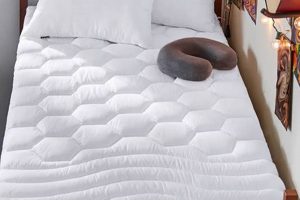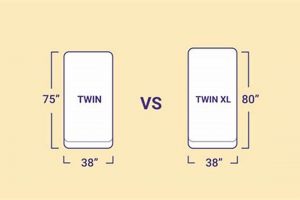The terms describe two distinct mattress sizes, both variations of what is commonly referred to as a ‘double’ bed. The standard version measures approximately 54 inches wide and 75 inches long. The extended-length version maintains the same width but increases the length to around 80 inches. This additional length caters specifically to individuals requiring more legroom during sleep.
Choosing the appropriate mattress size is crucial for ensuring adequate sleep quality and physical comfort. Factors such as individual height, sleeping habits, and available bedroom space significantly influence the decision-making process. Historically, bed sizes have evolved to accommodate changing population demographics and preferences for increased personal space.
This article will delve into a detailed comparison of these two mattress sizes, exploring their suitability for various user profiles, space constraints, and comfort requirements. Subsequent sections will examine specific dimensions, advantages, disadvantages, and ideal use cases to facilitate an informed purchase decision.
Considerations When Choosing Between Mattress Sizes
Selecting the correct mattress dimensions is paramount for optimizing sleep quality and overall comfort. The following considerations offer guidance when evaluating options in this mattress category.
Tip 1: Assess Individual Height: Individuals exceeding six feet in height should prioritize the extended-length version to prevent discomfort associated with insufficient legroom. A standard size may lead to restricted movement and disrupted sleep.
Tip 2: Evaluate Room Dimensions: Measure the available space within the bedroom before making a purchase. The extended-length version requires a larger footprint, and ensuring adequate clearance for movement around the bed is essential.
Tip 3: Consider Sleeping Habits: Individuals who tend to stretch out or move frequently during sleep may benefit from the additional length provided by the extended version. This accommodates a wider range of sleeping positions.
Tip 4: Evaluate Co-Sleeping Needs: While both sizes are typically designed for single sleepers, the standard width may prove restrictive for couples. Assess individual space requirements within the bed if shared occupancy is anticipated.
Tip 5: Consider Frame and Bedding Compatibility: Ensure that existing bed frames and bedding accessories are compatible with the chosen mattress dimensions. Adapters or custom solutions may be required if compatibility is not readily available.
Tip 6: Consider Budget Constraints: The extended-length version may command a slightly higher price point due to the increased material requirements. Factor budget considerations into the decision-making process.
Adhering to these considerations enables a more informed selection process, maximizing comfort and optimizing sleep quality. Prioritizing individual needs and spatial limitations will yield the most satisfactory outcome.
The subsequent section will offer a concluding summary, reinforcing the key distinctions and benefits associated with each mattress size.
1. Length
Length is the defining characteristic differentiating these mattress formats. The standard version offers a length of approximately 75 inches, while the extended length version provides around 80 inches. This difference, while seemingly minor, significantly impacts the overall comfort and suitability for specific individuals.
- Accommodation of Height
The extended length is specifically designed to accommodate individuals taller than average. Without sufficient length, taller sleepers may experience discomfort due to their feet hanging off the edge of the bed, leading to disrupted sleep patterns and potential physical strain. This additional length ensures proper spinal alignment and improved sleep quality.
- Impact on Room Aesthetics and Functionality
The increased length necessitates a larger room footprint. The longer mattress may affect the room’s spatial dynamics, potentially limiting movement or impacting the placement of other furniture. Careful measurement and consideration of room layout are essential to ensure the mattress integrates effectively within the existing space.
- Influence on Bedding Availability and Cost
The extended version requires specific bedding sizes to ensure a proper fit. Standard bedding sets designed for standard mattresses will not adequately cover the longer dimensions. This may necessitate purchasing specialized bedding, which can be more expensive and less readily available than standard sizes.
- Effect on Sleep Posture and Comfort
The extra length allows for a greater range of movement and sleeping positions without the constraint of reaching the end of the mattress. This freedom can be particularly beneficial for individuals who shift frequently during sleep or prefer to sleep on their back with their arms extended overhead. The increased space promotes more restful and undisturbed sleep.
In summary, the length disparity between the two sizes directly influences user comfort, room planning considerations, and bedding requirements. Choosing appropriately based on individual height and sleeping preferences is crucial for maximizing the benefits of the selected mattress type, ultimately contributing to better sleep and overall well-being.
2. Bedroom Space
Bedroom space is a fundamental constraint when choosing between these mattress dimensions. The existing area dictates the practicality of accommodating either the standard or extended-length option, influencing room functionality and aesthetics.
- Room Dimensions and Layout
The physical size and configuration of the bedroom directly determine the feasibility of incorporating a larger mattress. Smaller rooms may only comfortably accommodate the standard size, preventing overcrowding and ensuring sufficient space for movement. Room layout, including door and window placement, affects available wall space and pathway clearance.
- Furniture Placement and Movement
A larger mattress reduces the available floor space for other furniture, such as dressers, nightstands, and chairs. Overcrowding can impede movement within the room, creating a cramped and uncomfortable environment. Careful planning and consideration of furniture placement are crucial to optimize space utilization.
- Aesthetic Considerations
The size of the mattress relative to the room dimensions impacts the overall aesthetic appeal of the space. A mattress that is too large can dominate the room, making it appear smaller and less inviting. Conversely, a mattress that is too small may appear disproportionate. Achieving a balanced and visually pleasing aesthetic requires careful consideration of scale and proportion.
- Long-Term Functionality and Adaptability
Choosing a mattress that fits comfortably within the existing bedroom space ensures long-term functionality and adaptability. The ability to move freely, arrange furniture, and maintain a sense of openness contributes to the overall comfort and livability of the room. Selecting the appropriate mattress size is an investment in the long-term usability and enjoyment of the bedroom.
In conclusion, bedroom space serves as a primary determinant in the selection of these mattresses. Balancing spatial constraints, furniture requirements, and aesthetic considerations enables a well-informed decision, optimizing both comfort and room functionality. Prioritizing these factors contributes to a harmonious and functional bedroom environment.
3. Individual Height
Individual height exerts a direct influence on mattress size selection within the “full vs full xl mattress” category. This anthropometric factor serves as a primary determinant of sleep comfort and musculoskeletal health. Insufficient mattress length, relative to individual height, precipitates a compromised sleep posture. For instance, an individual exceeding 6 feet may experience discomfort and interrupted sleep when confined to a 75-inch mattress due to constrained leg extension. This limitation causes the sleeper to either bend their knees or allow their feet to hang off the mattress edge, resulting in spinal misalignment and potential muscle strain. The taller individual’s physiological need for extended sleeping space directly correlates with the necessity of the 80-inch “xl” variant. Thus, height functions as a causative agent influencing mattress size requirements.
The selection of an appropriate mattress size predicated on individual height offers several practical advantages. Firstly, it promotes optimal spinal alignment during sleep, reducing the risk of back pain and associated musculoskeletal issues. Secondly, adequate legroom facilitates unrestricted movement, fostering more restful and uninterrupted sleep cycles. Thirdly, a mattress that accommodates the individual’s full body length provides a more comfortable and supportive sleep surface, contributing to improved sleep quality. For example, athletes, known for their typically above-average height, often prioritize extended-length mattresses to facilitate muscle recovery and overall physical well-being during sleep. This demonstrates a direct application of height considerations in mattress selection.
In conclusion, individual height represents a critical parameter in the “full vs full xl mattress” decision-making process. Its influence extends beyond mere comfort, impacting spinal health, sleep quality, and overall physical well-being. Overlooking this correlation can lead to compromised sleep and potential musculoskeletal complications. Therefore, accurately assessing individual height and aligning it with the appropriate mattress dimensions remains paramount for achieving optimal sleep outcomes.
4. Co-Sleeping Suitability
The term refers to the capacity of a mattress to comfortably and safely accommodate multiple occupants, typically adults, or adults and children. The implications for mattress selection within the “full vs full xl mattress” category are significant, as dimensions directly affect the feasibility and comfort of shared sleep.
- Space per Occupant
A standard size offers limited space for two adults, approximately 27 inches per person. This restricted area often leads to discomfort, disrupted sleep, and increased likelihood of one or both occupants disturbing the other. The extended-length variant does not address the width constraint, maintaining the same inadequate personal space for co-sleeping adults. Shared sleep is often not an optimum with full size.
- Motion Transfer
The ability of a mattress to isolate motion is crucial for co-sleeping. Mattresses with poor motion isolation transfer movement from one occupant to the other, leading to frequent awakenings and reduced sleep quality. While mattress construction materials influence motion transfer, the limited surface area inherently exacerbates the issue within these smaller mattress dimensions. This lack of space is critical problem.
- Edge Support
Adequate edge support is essential for maximizing usable sleep surface, particularly in shared sleep arrangements. Weak edge support causes the mattress to compress near the edges, making occupants feel as though they might roll off. Limited width coupled with poor edge support further diminishes the comfort and security of co-sleeping, especially for couples.
- Thermal Regulation
Body heat generated by multiple occupants can lead to increased mattress temperature, causing discomfort and sleep disruption. Mattresses with poor thermal regulation exacerbate this issue. The limited surface area concentrates body heat, making temperature management more challenging than in larger mattress sizes. This can result in less restful shared sleep.
In conclusion, neither option is ideally suited for consistent co-sleeping between adults. The standard and extended length variants both suffer from inadequate width, leading to compromised personal space, heightened motion transfer, reduced edge support, and potential thermal regulation issues. For couples or co-sleeping adults, larger mattress sizes such as queen, king, or California king are generally recommended to ensure sufficient comfort and undisturbed sleep.
5. Bedding Compatibility
Bedding compatibility constitutes a critical consideration within the context of mattress selection. The phrase “full vs full xl mattress” specifically delineates dimensional variances that directly impact the suitability of standard bedding items. The dimensions dictate whether existing sheets, blankets, and comforters will appropriately fit the chosen mattress. Discrepancies in size can lead to ill-fitting bedding, resulting in discomfort, reduced aesthetic appeal, and premature wear due to increased stress on the fabric. The extended-length version necessitates specialized bedding designed to accommodate its additional length, while the standard size typically aligns with readily available bedding options.
A mismatch between mattress and bedding sizes presents several practical challenges. For instance, standard sheets may not adequately cover the corners of an extended-length mattress, leading to slippage and nightly readjustments. Similarly, a comforter designed for a standard size may appear disproportionately small on an extended-length bed, detracting from the overall visual presentation of the bedroom. The financial implications extend beyond the initial bedding purchase, as the need for replacement or custom-made items can significantly increase the overall cost. Furthermore, the reduced availability of extended-length bedding options may limit stylistic choices.
In summary, bedding compatibility functions as an integral component in the effective utilization and long-term satisfaction with either mattress size. Failure to account for this factor can lead to functional inconveniences, aesthetic compromises, and increased financial burdens. Ensuring congruence between mattress dimensions and bedding size remains paramount for optimizing sleep comfort, maximizing bedding lifespan, and maintaining the desired visual coherence within the bedroom environment.
Frequently Asked Questions
The following questions and answers address common inquiries regarding the distinctions, applications, and selection criteria associated with these mattress sizes.
Question 1: Is one mattress inherently superior to the other?
No, neither mattress holds intrinsic superiority. Suitability hinges on individual requirements, physical attributes, and spatial constraints. The extended-length version is advantageous for taller individuals, while the standard version may suffice for those of average height or when space is limited.
Question 2: What is the primary advantage of selecting the extended-length version?
The principal benefit lies in accommodating individuals exceeding six feet in height. This additional length prevents discomfort associated with restricted legroom, promoting improved spinal alignment and uninterrupted sleep cycles.
Question 3: Does the extended-length version require specialized bed frames?
Typically, yes. Standard bed frames are designed to accommodate the dimensions of standard mattresses. The extended-length version necessitates a compatible frame, either specifically manufactured for that size or adaptable through the use of extenders or modifications.
Question 4: Are bedding costs higher for the extended-length version?
Generally, yes. Bedding designed for the extended-length dimensions is often more expensive than standard sizes due to increased material usage and potentially lower production volumes. Availability may also be more limited, impacting pricing.
Question 5: Can the standard mattress accommodate two adults?
While technically possible, this size is not optimal for shared sleep between two adults. The limited width (approximately 54 inches) restricts personal space, potentially leading to discomfort and disrupted sleep for both occupants. Larger mattress sizes are recommended for co-sleeping.
Question 6: How does room size influence the decision between the two mattress sizes?
Smaller bedrooms may be better suited for the standard size. The extended-length version requires additional floor space, potentially impacting room functionality and movement. Careful measurement and consideration of room layout are essential to ensure adequate space utilization.
In summary, the selection of mattress dimensions should be based on a thorough assessment of individual height, spatial limitations, and budgetary considerations. Understanding the nuances of each option enables a well-informed purchase decision.
The following section will offer a concluding summary, reiterating the key considerations and providing final recommendations for prospective purchasers.
full vs full xl mattress
The preceding analysis has explored the critical distinctions and considerations surrounding “full vs full xl mattress” options. Key points include the importance of individual height, spatial limitations, bedding compatibility, and suitability for co-sleeping arrangements. The extended-length variant offers advantages for taller individuals, while the standard version may suffice for those of average height or in constrained spaces. Ultimately, informed selection relies on a comprehensive assessment of these factors.
The selection of an appropriately sized mattress is a crucial investment in long-term sleep quality and physical well-being. Prospective purchasers are encouraged to meticulously evaluate their individual needs and spatial constraints before committing to a particular size. A well-informed decision will contribute significantly to enhanced sleep comfort and overall quality of life.





![Best XL Twin Mattress Protector [Guide & Reviews] Organic & Natural Mattress Buyer’s Guide: Non-Toxic Sleep Solutions Best XL Twin Mattress Protector [Guide & Reviews] | Organic & Natural Mattress Buyer’s Guide: Non-Toxic Sleep Solutions](https://mattressworldpa.com/wp-content/uploads/2025/07/th-881-300x200.jpg)

